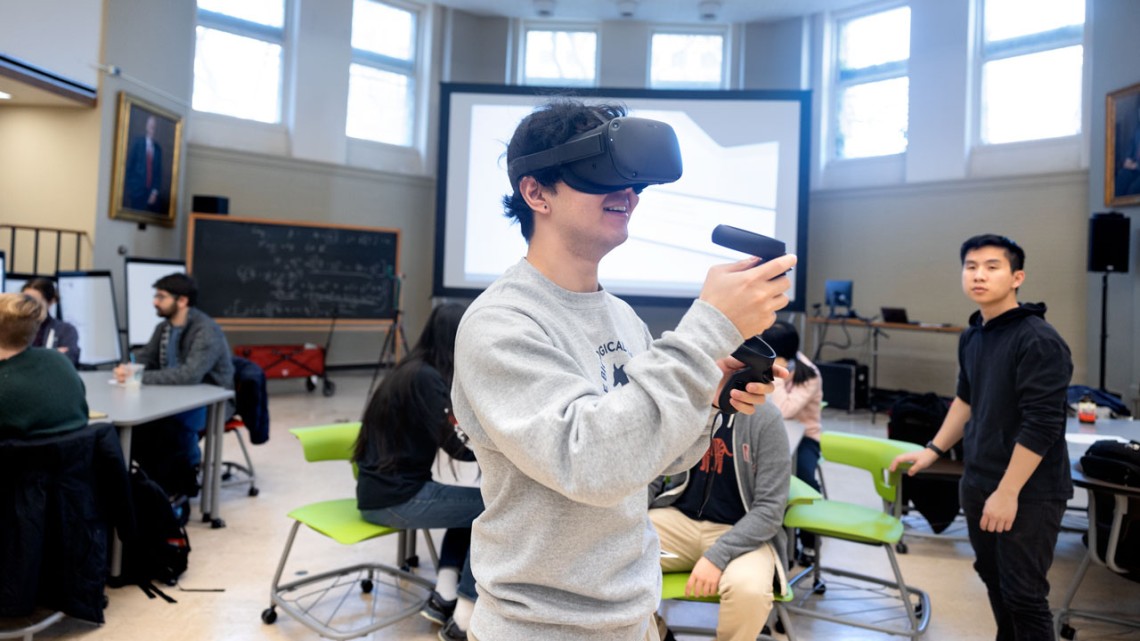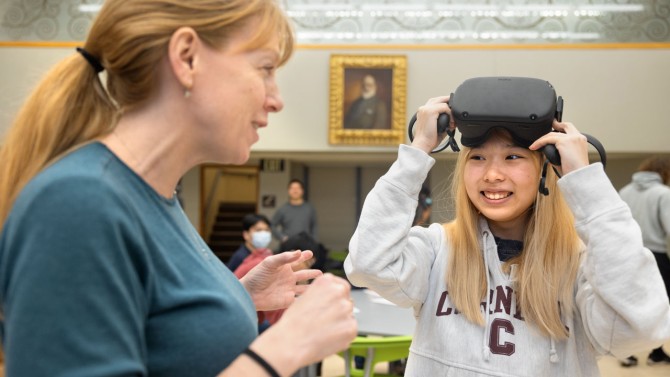
A student uses a VR headset as Jackwin Hui, right, a student technology specialist at CTI who helped to set up and troubleshoot the headsets, looks on.
Students visit virtual world to learn research technique
By Kathy Hovis
Safely and effectively preparing a sample for cryo-electron microscopy involves a series of precise steps, resulting in specimens frozen at around minus 180 degrees Celsius. If done out of order or imprecisely, the scientist can obtain inaccurate results, ruin expensive equipment or even get hurt.
The technique isn’t often available to young researchers, but students in the Protein Structure and Function class recently had the chance to experience the process using virtual reality (VR) headsets, as part of a collaboration with Cornell’s Center for Teaching Innovation (CTI). CTI is available to consult with instructors designing thoughtful student learning experiences in virtual reality.
The class is taught by Elizabeth Kellogg, assistant professor of molecular biology and genetics in the College of Arts and Sciences.
Students excitedly donned the headsets and focused intently on completing the tutorials, which plunged them into a virtual world where they used hand controls to grab tiny samples with tweezers, manipulate a stylus to enter information, and lift and replace lids on equipment, among other tasks.
“I’ve never done VR before. You very much feel like you’re somewhere else, not in this room,” said Daniel Eweis-LaBolle, a first-year doctoral student in the biochemistry, molecular and cell biology graduate program. “I think this would help you remember the steps.”
The idea for the VR session came from Vinh Truong, a teaching assistant for the class and doctoral student in Kellogg’s lab. Truong tried out the VR software, created by Purdue University, during a spring training session and wanted to bring it back to students.
“These protein samples can take weeks and weeks to prepare, and you only have a very limited amount of material. Plus, they’re very sensitive to temperature, so you’re trying to move quickly,” Truong said. “There are multiple steps and a lot of things can go wrong, so this VR training provides a really safe environment to try out everything and get used to the instructions and steps.”
Staff from CTI helped Truong obtain the headsets from the Milstein Program in Technology and Humanity and from Andrea Stevenson Won, assistant professor of communication in the College of Agriculture and Life Sciences, and director of the Virtual Embodiment Lab. CTI staff and students from the CTI Tech Lab also loaded the software onto the headsets and handled the logistics for the class session.
Kellogg said cryo-electron microscopy is “taking over the structural biology field. So many people are trying to get into it that there’s a shortage of equipment and training.”
Cryo-electron microscopy gives researchers the ability to look at the atomic arrangements of proteins, to better understand how they function.
“People think of proteins as being in your food, but they are actually the molecular machines that make our cells function. They are what distinguishes living things from nonliving things,” Kellogg said. “When you have cancer or a genetic disease, they are in many cases caused by proteins not functioning properly, so studying protein structure is one of the most important things we can do to understand how to cure diseases.”
This semester’s class learned about other techniques for examining proteins, including X-ray crystallography and nuclear magnetic resonance imaging. Students also used machine learning to predict the structure of proteins, Kellogg said.
Andrew Rhee ’23, a biological sciences major concentrating in computational biology, said the combination of techniques and information he’s learned are contributing to his knowledge of the interplay between computation and biology.
“I feel like combining the fields can make things easier for scientists and open up a lot of applications for research,” he said.
Kellogg said she hopes to include the VR training in her class when it’s offered again.
“We’ll also be working in class to give them a feeling of how you translate your VR experience to the real world,” she said. “VR environments are going to be increasingly used to train practitioners in the field.”
Kathy Hovis is a writer for the College of Arts and Sciences.
Media Contact
Get Cornell news delivered right to your inbox.
Subscribe

